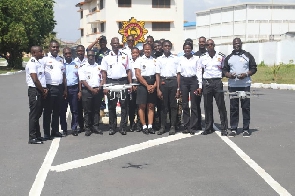The personnel of the Ghana National Fire Service (GNFS) has been taken through the rudiments of drone fire-fighting by Hadad Media Consult in Accra
Describing how drones work, the Chief Executive Officer of Hadad Media Consult, Mr Jones Owusu Yeboah, explained that drones, commonly known as unmanned aerial vehicles (UAVs), evolved from military applications to becoming indispensable tools in emergency response scenarios worldwide.
Ranging from the size of an aircraft to the palm of one's hand, these unmanned crafts are demonstrating their versatility in executing a diverse array of tasks, from military operations to innovative services like package delivery, he noted.
He said one noteworthy application of drones gaining traction is in emergency response situations.
''With the ability to swiftly navigate challenging terrains and provide real-time data, drones are increasingly becoming crucial assets for first responders,'' he noted.
Speaking at the training on the use and flying of drones held for personnel of the GNFS, Mr Yeboah further noted the utilisation of payload drop systems further enhances their capabilities, enabling them to deliver various equipment to aid in emergency situations.
According to him, one of the game-changing features is the integration of thermal (infrared) cameras, allowing drones to see through smoke and observe objects emitting energy in complete darkness.
This technology, he said, proves invaluable in assessing the extent and severity of incidents, providing critical information for commanders of the service to determine the required resources and overall response objectives.
He noted that the firefighting sector is particularly benefiting from drone technology, with innovations like the firefighter drone powder extinguisher. This advancement, he noted, allows drones to deploy extinguishing agents swiftly and precisely, enhancing firefighting capabilities and minimizing risks to human responders.
''As drones continue to prove their worth in emergency response, their role is expected to expand, revolutionising how crises are managed and mitigated.
“The integration of these unmanned vehicles not only improves the efficiency of operations but also enhances the safety of responders and the effectiveness of overall emergency response strategies'' he concluded.
General News of Friday, 5 January 2024
Source: classfmonline.com

















